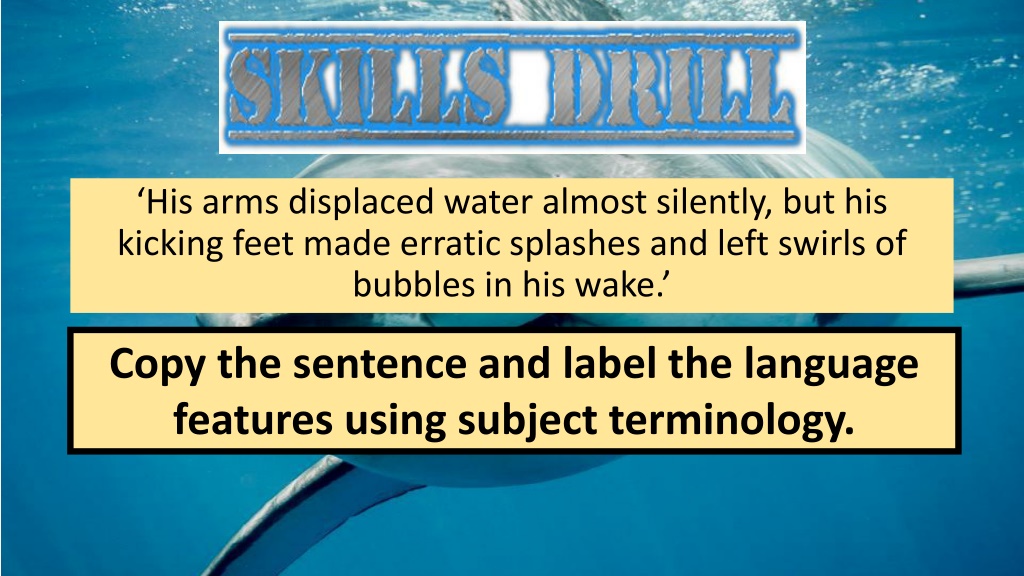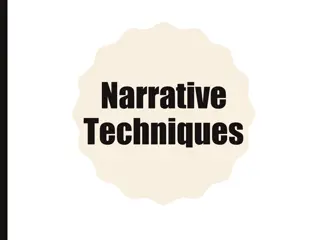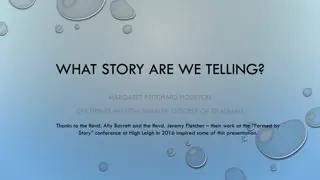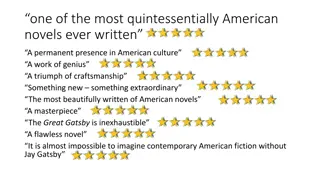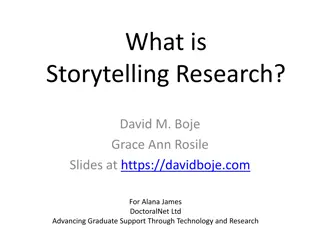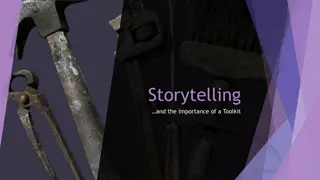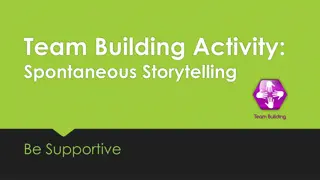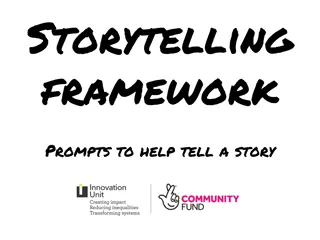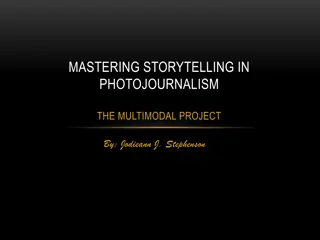Exploring Language Features in Storytelling
Delve into the intricate language techniques used to evoke various emotions and portray the innocence of the boy in a seaside setting. Analyze the impact of subject terminology, vivid descriptions, and narrative elements on the reader's experience.
Download Presentation

Please find below an Image/Link to download the presentation.
The content on the website is provided AS IS for your information and personal use only. It may not be sold, licensed, or shared on other websites without obtaining consent from the author. Download presentation by click this link. If you encounter any issues during the download, it is possible that the publisher has removed the file from their server.
E N D
Presentation Transcript
His arms displaced water almost silently, but his kicking feet made erratic splashes and left swirls of bubbles in his wake. Copy the sentence and label the language features using subject terminology.
Sharks: Q3 We ve read two articles about sharks and written a summary. Now we need to focus on our language analysis skills. Write down the three language techniques you can remember the easiest. For each language technique, what effect can it have on the reader? If you were going to try to make something sound tense and frightening, which techniques would be the best to use as writer? Why?
Comment on how the words in bold portray the youth and innocence of the boy. The boy was resting, his arms dangling down, his feet and ankles dipping in and out of the water with each small swell. His head was turned towards shore, and he noticed that he had been carried out beyond what his mother would consider safe. He could see her lying on her towel, and the man and child playing in the wavewash. He was not afraid, for the water was calm and he wasn t really very far from shore only forty yards or so. But he wanted to get closer; otherwise his mother might sit up, spy him, and order him out of the water. He eased himself back a little bit so he could use his feet to help propel himself. He began to kick and paddle towards shore. His arms displaced water almost silently, but his kicking feet made erratic splashes and left swirls of bubbles in his wake.
Comment on how the words in bold portray the youth and innocence of the boy. Write a short sentence for each word or phrase. The boy was resting, his arms dangling down, his feet and ankles dipping in and out of the water with each small swell. His head was turned towards shore, and he noticed that he had been carried out beyond what his mother would consider safe. He could see her lying on her towel, and the man and child playing in the wavewash. He was not afraid, for the water was calm and he wasn t really very far from shore only forty yards or so. But he wanted to get closer; otherwise his mother might sit up, spy him, and order him out of the water. He eased himself back a little bit so he could use his feet to help propel himself. He began to kick and paddle towards shore. His arms displaced water almost silently, but his kicking feet made erratic splashes and left swirls of bubbles in his wake.
Write a short sentence commenting on how the words in bold portray the youth and innocence of the boy. 1. The noun boy implies vulnerability. 2. The verb dangling suggests being in a helpless state. 3. The adjective small in small swell highlights the limited impact that the boy is having on the water. 4. The phrase he had been carried out beyond what his mother would consider safe , is used to indicate his lack of power. 5. The use of the modal verb might in the phrase his mother might sit up, spy him, demonstrates that he is still young enough to be worried about getting into trouble. For the boy, at that particular moment, the greater danger is his mother, not the shark.
How focus on the methods that the writer has used. Question Three How does the writer use language to describe the shark s attack? This part changes depending on the text. In this case you should look for anything that tells you what the shark attack is like. language refer specifically to words, phrases and language features
How does the writer use language to describe shark s attack shark s attack? describe the The boy s last only thought was that he had been punched in the stomach. The breath was driven from him in a sudden rush. He had not time to cry out, nor had he had the time, would he have known what to cry, for he could not see the fish. The fish s head drove the raft out of the water. The jaws smashed together, engulfing head, arms, shoulder, trunk, pelvis and most of the raft. Nearly half the fish had come clear of the water, and it slid forward and down in a belly flopping motion, grinding the mass of flesh and bone and rubber. The boy s legs were severed at the hip, and they sank, spinning slowly to the bottom.
How does the writer use language to describe shark s attack shark s attack? the boy s last only thought describe the What language technique has been employed? What impression does this create? shows how quickly and out-of-the-blue the attack happened parenthesis What specific words create this technique? The word only
How does the writer use language to describe shark s attack shark s attack? describe the The writer s use of parenthesis in the quotation, the boy s last only thought shows how rapidly the attack happened and how quickly the boy has been killed by the shark, which demonstrates the shark s power. This creates sympathy from the reader because he is a young child whose future is lost.
How does the writer use language to describe shark s attack shark s attack? describe the the jaws smashed together What language technique has been employed? What impression does this create? shows destructive capabilities of the shark and its attack on the boy verb phrase What specific words create this technique? The verb smashed
How does the writer use language to describe shark s attack shark s attack? describe the The verb phrase the jaws smashed together shows the destructive capabilities of the shark during its attack on the boy. The use of the determiner the instead of its gives the shark s jaws a formidable power of their own, demonstrating to the reader that they are something to fear.
Choose one of the phrases in bold to analyse in more detail. The boy s last only thought was that he had been punched in the stomach. The breath was driven from him in a sudden rush. He had not time to cry out, nor had he had the time, would he have known what to cry, for he could not see the fish. The fish s head drove the raft out of the water. The jaws smashed together, engulfing head, arms, shoulder, trunk, pelvis and most of the raft. Nearly half the fish had come clear of the water, and it slid forward and down in a belly flopping motion, grinding the mass of flesh and bone and rubber. The boy s legs were severed at the hip, and they sank, spinning slowly to the bottom.
Example Answers The use of listing in the quotation, engulfing head, arms, shoulder, trunk, pelvis and most of the raft suggests that the shark has consumed almost every part of the boy and his raft, signifying its immense strength and hunger for blood. The ordering of the body parts allows the reader to imagine the boy being swallowed head first, inciting fear in the reader. The use of imagery in the quotation, grinding the mass of flesh and bone and rubber reveals the outcome of the shark s attack: it has reduced the young boy to nothing but a bloody mess. The imagery is violent and uncomfortable for the reader, who is likely to be horrified by his death. The use of sibilance in the quotation, they sank, spinning slowly to the bottom creates a softer tone than the previous descriptions, leaving a harrowing impression on the reader as the last whole part of the boy sinks slowly to the bottom of the sea. The shark s attack has completely destroyed him.
MAP Question 3 MAP Question 3 How does Richard Wands use language to make his experience sound tense and frightening? You should write about: What happens to him Words and phrases he uses
It was a beautiful morning. I was surfing thirty metres off-shore when a shark swam underneath my surfboard. I guessed it was either a tiger shark or a bull shark. I knew it wasn t a great white shark, like in the film Jaws , because they live in colder waters. But I was still terrified because bull sharks and tiger sharks can attack and kill a human. As it came closer I could see it had tiger-like stripes on its back. I know exactly how dangerous these sharks are; where I live, they ve killed five people in the last eighteen months. I was very scared and knew it was going to attack. It swam under my legs, so close I could have placed my surfboard on its back. Through the crystal clear water, I could see its bulging eyes and terrifying teeth. It looked merciless and mean. I knew I had to do something or I was going to lose an arm, a leg, or even my life. The shark sped off, did a U-turn, and came straight for me. I felt totally exposed and realised it wanted a chunk of me. I picked up my surfboard and used it to smash the shark s face again and again. It swam away, but turned around and went for me again. I was terrified. I knew it was a case of life or death. I tried to spear the shark with my surfboard and hit down at it. To my immense relief the shark appeared to have had enough because it turned away from me and headed out to sea. I paddled furiously to shore, yelling loudly to alert others ito the killer shark. As I collapsed on the beach, unscathed, I kissed the sand; it tasted gritty and crunchy but it was wonderful. Still trembling with fear, I looked up to see four tiger sharks feasting on a dolphin carcass just offshore. I realised that could have been me and a shiver passed through my body. There were ten other surfers nearby and a group of children happily playing in the shallows. I alerted the lifeguard who sounded the alarm and closed the beach. I never want to see another shark, even a basking shark that eats only plankton and has never attacked a human.
Self Assessment Q3 Level Four Your answer is perceptive and detailed. What are your strengths? How could your answer be developed? Level Three Your answer is clear. You know your stuff! Level Two You re still not quite sure yet. You have the basics, but it s not 100% clear. Clearly and accurately identify the names of the techniques Use a range of appropriate quotations Level One Your answer is quite simple and lacking in detail. Explore the different effects of the writer s language techniques
